Excerpts from Jim Conrad's
Naturalist Newsletter
Entry dated November 7, 2023, from notes taken at Cascadas de La Piedad waterfall 3kms NW of the community of San Pablo, municipality of Almeaco de Bonfil; bedrock of volcanic andesite; N20.1008°, W100.0041°, elevation 2360 meters (7750ft); extreme southern Querétaro state, MÉXICO
HOLCUS LANATUS
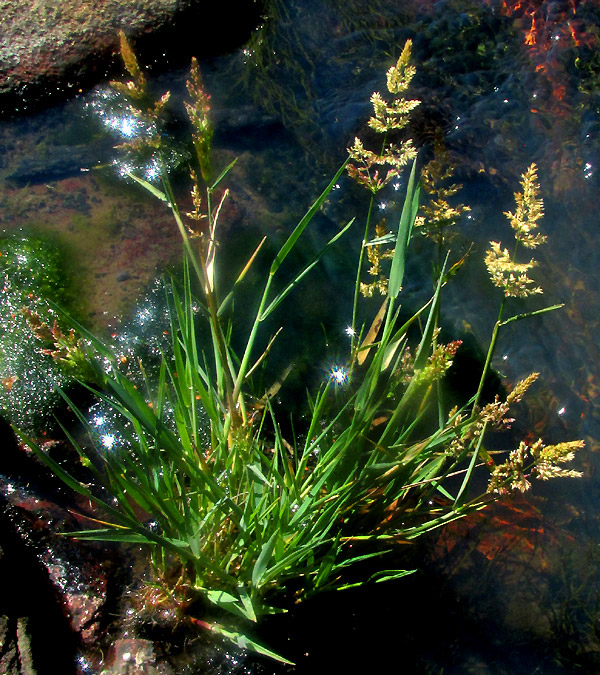
Even during the ongoing two-year dry period classified by the "North American Drought Monitor" as an extreme D3 drought, a small stream of clear, cold water meandered across a livestock-grazed meadow atop a bed of hard volcanic andesite rock. Just before tumbling over a high ledge to create the picturesque Cascada de La Piedad, or Piety Waterfall, the above grass flourished at the water's edge, rooting in mud at the water's edge, as shown below:
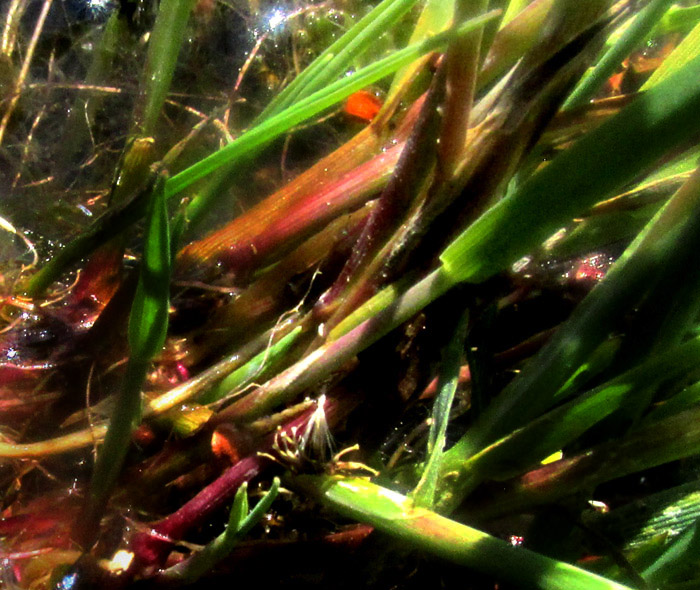
Emerging from shallow water, the grass's stems bore white, adventitious roots at the lower nodes. Assuming that the grass was semiaquatic, in a region that's generally somewhat arid, I thought this might be a rare species; certainly I'd not noticed it in these central Mexican highlands. The grass's pyramid-shaped inflorescence was a noteworthy field mark:
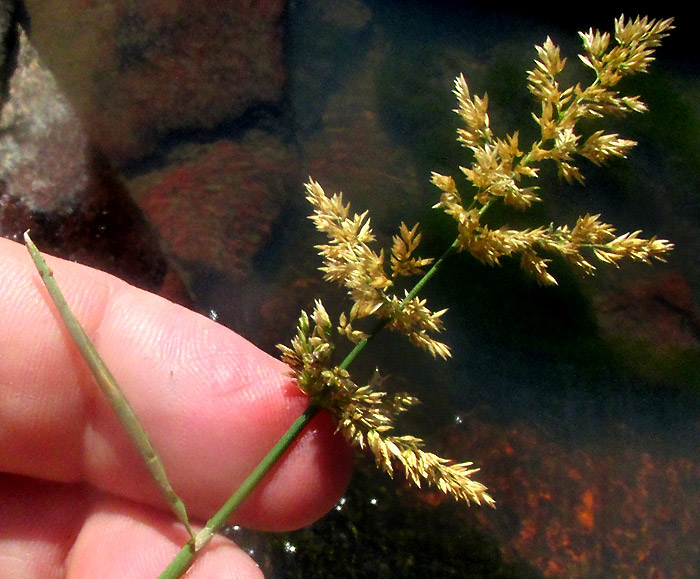
Note how crowded the spikelets are on their short branches. A leaf arises stiffly not far below the inflorescence.
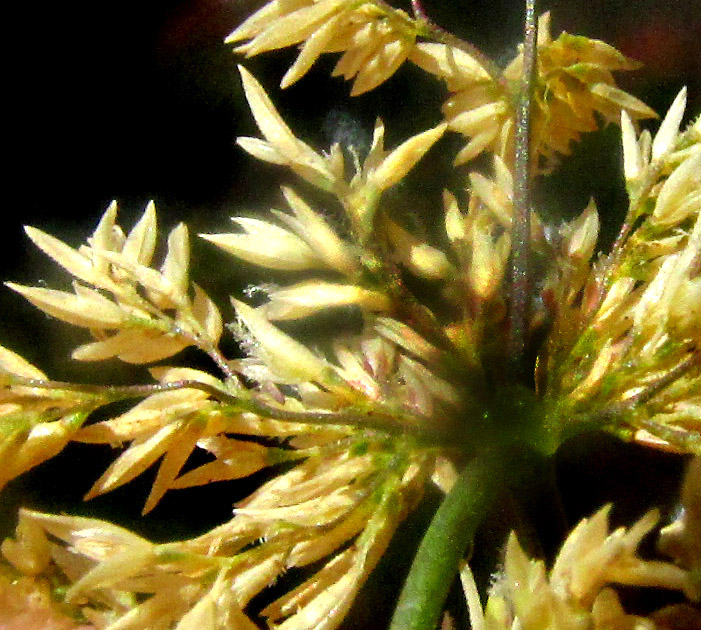
Branches off the inflorescence's main axis arose in whorls. The branch stems were slender, stiff and dark purplish. These features are helpful field marks for identification, but they are seen in species of several large grass genera, such as the bluegrasses (Poa), bentgrasses (Agrostis) and mannagrasses (Glyceria). Flower structure would provide more critical details.
Up close, the first notable floral detail was that the vast majority of spikelets were empty, apparently the florets already having produced their caryopsis-type fruits, and dispersed them, leaving only the spikelets' lower scales, the glumes. 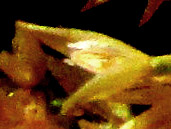 At the right, a detail from the lower, left corner of the above picture shows a pair of yellowish glumes which are not empty, but rather sheltering between them two white scales. These scales are the lemma and palea of a floret, and the critical detail to consider is that the lemma and palea are only about half as long as the glumes. Most grass spikelets produce glumes shorter than the lemmas and paleas above them.
At the right, a detail from the lower, left corner of the above picture shows a pair of yellowish glumes which are not empty, but rather sheltering between them two white scales. These scales are the lemma and palea of a floret, and the critical detail to consider is that the lemma and palea are only about half as long as the glumes. Most grass spikelets produce glumes shorter than the lemmas and paleas above them.
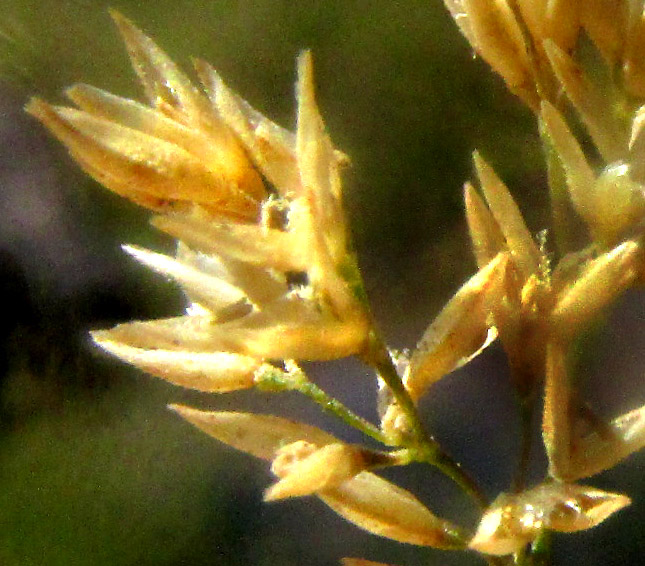
Above, more florets are seen close up, some with the tips of lemmas and paleas showing, as well as white, fuzzy stigmas atop ovaries.
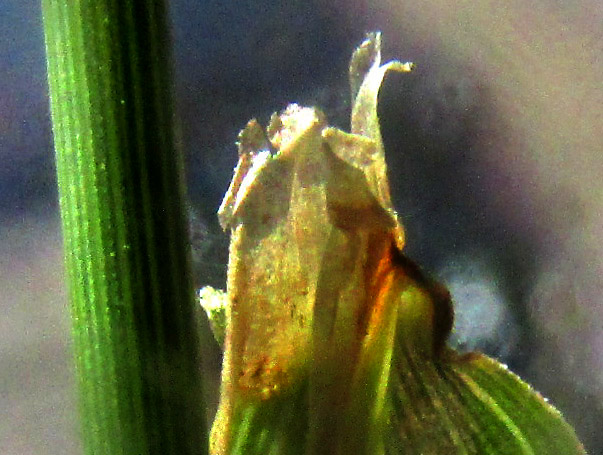
The white, papery item featured above is the ligule arising where a leaf base meets the stem and wraps around it. Many ligule types exist, some composed of hairs which may be long or short, dense or sparse, and some ligules are papery, like the above, but maybe solid or, like the above, variously incised. Also, sometimes they're simply absent. Whatever their condition, their appearance is important in grass identification.
Identifying this grass has been hard. It's native to Europe but widely distributed in North America and elsewhere as an invasive, but here in Mexico it's only been documented occasionally. Still, this appears to me to be HOLCUS LANATUS, known by several English names. In Europe it's most likely to be called Yorkshire Fog, Tufted Grass, or Meadow Soft Grass, while in North America its names include Velvet Grass and Common Velvet Grass.
The Flora of North America says that Holcus lanatus "... grows in disturbed sites, moist waste places, lawns and pastures, in a wide range of edaphic conditions." The word edaphic refers to influences of the soil. Our plant is not semiaquatic, as it might seem, but flexible enough to grow in mud.
The "velvet" in the American names refers to the short, soft hairs covering the grass's leaves and stems. Our plant is not at all velvety, though its vegetative parts sparsely bear tiny stubs, like the bases of hairs. Also, spikelets of Holcus lanatus contain two florets, the upper one being sterile, and developing a needlelike awn 1-2mm long. No awns are apparent on our florets, though maybe the sterile ones bearing awns have fallen off or haven't yet developed.
Still, our plant's basic structural features agree with those of Holcus lanatus. Also, the 1961 entry for Holcus lanatus by A.R. Beddows in the British Ecological Society's Journal of Ecology refers to a forma muticus with short or absent awns, as well as "completely glabrous forms," meaning hairless ones. It's apparent that Holcus lanatus is a variable species.
Our Mexican plants don't appear to have received much attention. In fact, relative to our current location, the closest documented occurrences I can find of Holcus lanatus are in the states of Michoacán and Puebla; there's no mention of it here in Querétaro state. Maybe here we have a new state record.